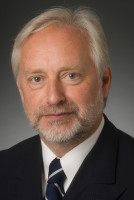
KEY POINTS:
ConocoPhillips values the connection it had with Dr. Jane Goodall, the world-renowned ethologist, anthropologist and conservation activist in the early 1990s when Conoco, the Jane Goodall Institute and the Government of the Congo worked together to improve the living conditions of captive orphan chimpanzees.
Since then, the Tchimpounga Chimpanzee Rehabilitation Center has been a haven for hundreds of chimpanzees and continues to save injured and orphaned chimps.
Despite exiting the country, the company honored its commitment to build the chimpanzee sanctuary.
Today, ConocoPhillips continues supporting proactive conservation through numerous legacy and ongoing relationships.
BY RAY SCIPPA
Dr. Jane Goodall's 90th birthday on April 3, 2024, provides an opportunity to consider the lessons of the past and how they apply to the energy industry today.

“The Congo situation was unusual, because we knew before we built the sanctuary that we would be exiting the country,” said ConocoPhillips Community Programs Manager Andrew Roberts. “It was an exercise in legacy, an example of honoring commitments and understanding that track record will matter in the future.”
At the time, former Conoco executive Rod MacAlister had been named the company’s Congo country manager. In that position, his mandate was to safely find oil … if possible.

MacAlister recalls drilling two dry holes in addition to the seven his predecessor had drilled. As a result, the company turned its attention to other countries, and he was instructed to shut down operations in the Congo.
“I said fine, but we haven’t delivered on our promise to Jane Goodall yet.”
That promise was to help plan and pay for a chimpanzee sanctuary for captured apes suffering under terrible conditions at the Brazzaville and Pointe Noire Zoos and the many future chimps orphaned by bushmeat hunters.
Asked how much building the sanctuary would cost, MacAlister informed headquarters that its cost had increased three times over the initial estimate.
Management's response was: “A promise is a promise, get it done.”
MacAlister, who after leaving ConocoPhillips held positions in government and is now advising the Center for Strategic and International Studies in Washington, was impressed by that decision.
“It would have been in Conoco's financial interest if we had defined things narrowly to nix the project,” he said. “We could have apologized to Jane. Tell her the idea ended up being more expensive, complex and risky than we ever realized. She'd have been forgiving. She'd have understood; she's very pragmatic. But my superiors said no, a promise is a promise.
“I have long carried immense respect for my former employer because of that integrity."
The SPIRIT Value of integrity remains a vital part of the ConocoPhillips DNA. The company’s commitment to proactive conservation is demonstrated by numerous legacy and ongoing relationships, including more than 100 years of support for Yellowstone National Park, longstanding partnerships with the Smithsonian Institution, Ducks Unlimited, the National Fish & Wildlife Foundation and many more.
Since 1917, ConocoPhillips has provided Yellowstone with millions of dollars in direct funding as well as leadership support. Over the years, the company has supported a wide range of initiatives and projects at the park, including helping to restore Inspiration Point and the Roosevelt Arch, preserving the historical Haynes Photo Shop, repairing more than 1,000 miles of park trails, protecting native fish and conducting a recycling study to help Yellowstone become one of the world’s greenest parks.
Overall, ConocoPhillips has contributed to nearly 21 million acres of total collaboration conservation. Through its partnership with Ducks Unlimited, for example, the company participates in projects that have enhanced more than 80,000 acres of vital wetlands in Louisiana.
Working with the Smithsonian and the National Fish & Wildlife Foundation among others, ConocoPhillips has taken an increasingly active role in helping to preserve and protect avian species and habitats. Collaboration with the Smithsonian Migratory Bird Center has increased understanding of important habitats in bird migration cycles and fostered a coordinated approach for more effective conservation. These birds include species that breed near company assets on the North Slope of Alaska and northern Alberta, then migrate south through Texas and across the Gulf of Mexico to wintering grounds as far south as Colombia.
According to ConocoPhillips Community Relations Director Natalie Riley, such proactive conservation programs are one of many ways the company engages with communities.

“Through charitable investments and employee volunteerism, we also support education, health and safety, the arts, social services and disaster relief,” she said. “We want to be a good neighbor and meaningfully contribute to each community’s unique needs. This can sometimes mean overcoming resistance to working with an oil and gas company.”
The spirit of collaboration despite differences is a lesson that transcends time and discipline, MacAlister said, highlighting Goodall's initiative to foster dialogue with those on opposing sides.
"Jane Goodall set the example," he said. "When asked why she would talk to an oil company when her community viewed us as the enemy, her answer was you will never make common cause or change anybody by not talking to them.”
While the Congo example was more than 30 years ago, Roberts said lessons from the past can inform the new era of large-scale domestic energy projects in LNG export, carbon capture, hydrogen and ammonia.
“Our commitment is to earn the trust and acceptance of communities near these projects by applying the same principles of thoughtfulness and shared value.”
